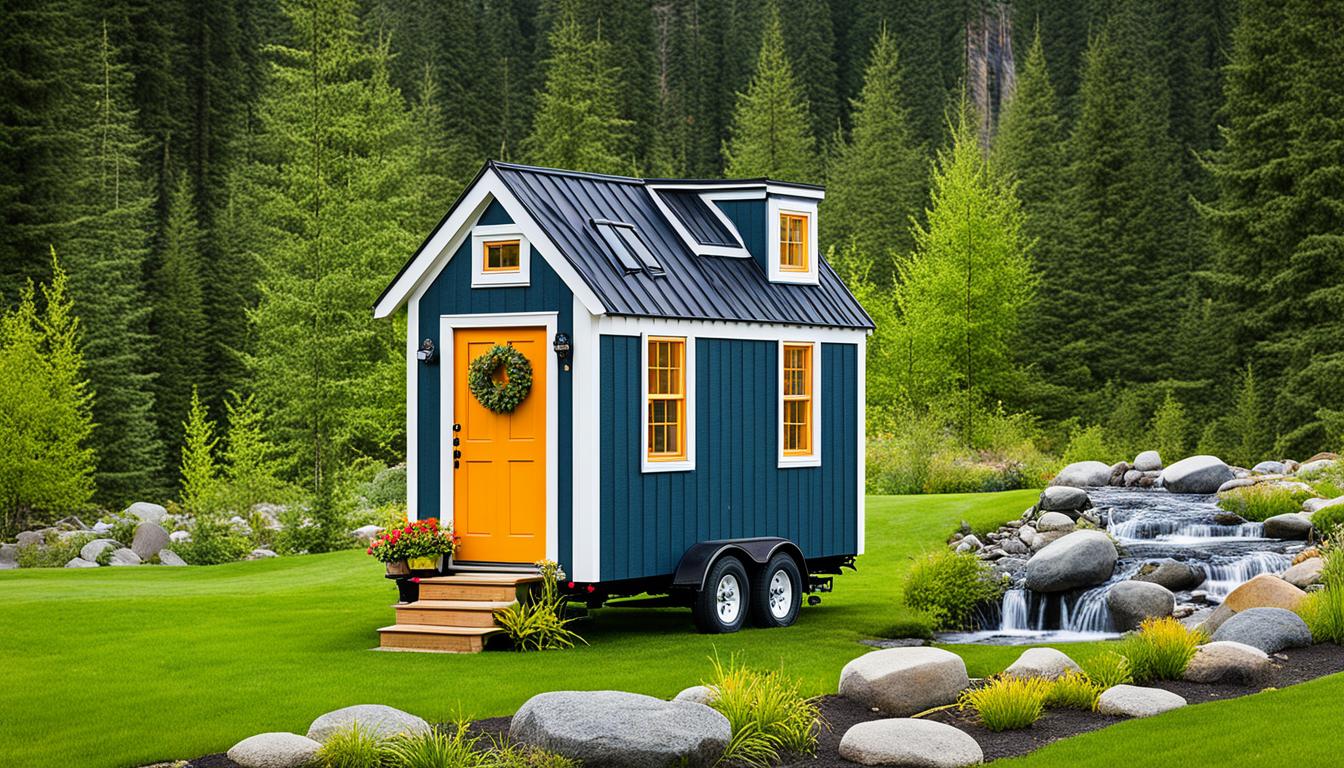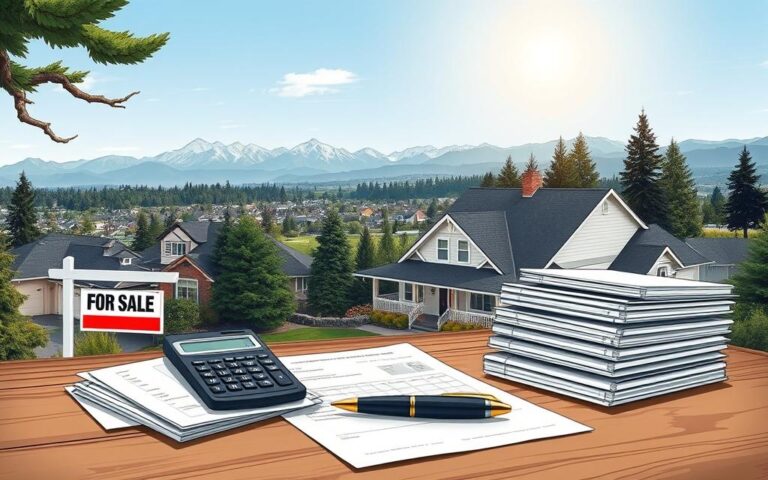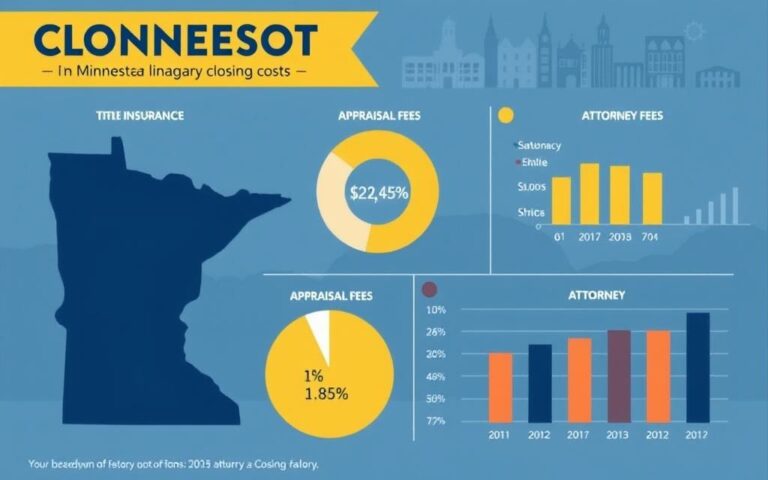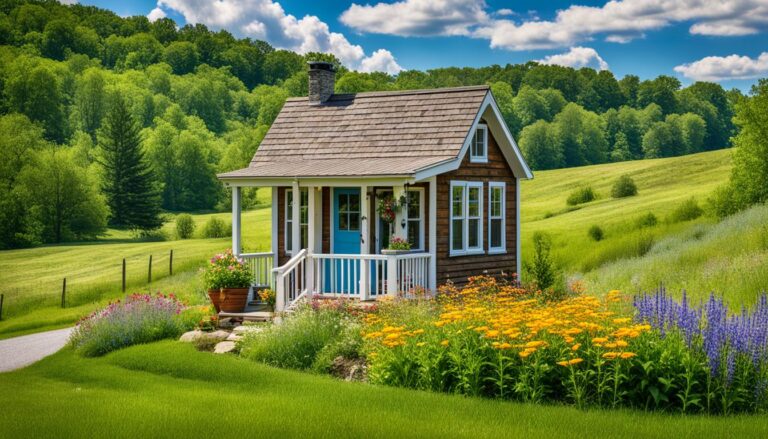Where Can I Put a Tiny House in Washington: A Guide
Did you know that tiny homes with a foundation are gaining popularity in Washington State? Thanks to the regulations for accessory dwelling units (ADUs) in many communities, tiny houses are becoming a viable housing option for many people. But where exactly can you put a tiny house in Washington? Let’s explore the regulations and zoning laws to find out.
Key Takeaways:
- Woodland allows ADUs ranging between 300 and 800 square feet.
- Tiny houses in King County must have a foundation.
- Parking a tiny house on wheels (THOW) anywhere in the state is illegal.
- Zoning laws and building codes have limitations and restrictions for tiny houses.
- It’s important to understand the regulations before building or buying a tiny house in Washington.
Are Tiny Homes Legal in Washington?
When it comes to tiny homes in Washington, the answer is generally yes – tiny homes are legal! However, it’s important to note that the regulations surrounding tiny homes may vary depending on the specific location within the state. Understanding these regulations is key to ensuring that your tiny home is compliant with the law.
In King County, for example, tiny houses must have a permanent foundation to meet the legal requirements. This means that if you’re planning to build or buy a tiny home in King County, you’ll need to ensure that it conforms to the foundation requirements set by the county’s regulations.
Woodland, on the other hand, allows Accessory Dwelling Units (ADUs) within a specific size range of 300 to 800 square feet. If you’re considering building an ADU in Woodland, it’s important to be mindful of this size restriction to ensure that your tiny home complies with local regulations.
In Seattle, tiny homes are classified as ADUs, and Tiny Houses on Wheels (THOWs) are not permitted. This means that if you’re planning to live in a tiny home in Seattle, it will need to be a permanent structure on a foundation, rather than a mobile tiny home.
Before embarking on your tiny home journey, it is crucial to consult with the local building department to fully understand the regulations and requirements specific to your desired location. By doing so, you can ensure that your tiny home complies with the Washington State Building Code and adhere to all the necessary legalities.
Living in a Licensed RV
In Washington, it’s also important to note that living in a licensed Recreational Vehicle (RV) for more than 180 days in the same spot is not permitted. This regulation aims to prevent long-term occupancy in RVs, ensuring that communities maintain a residential character and that individuals have adequate access to utilities and amenities.
While tiny homes offer a unique and exciting way of living, it’s crucial to familiarize yourself with the legal requirements and regulations before embarking on your tiny home journey in Washington. By doing so, you can ensure that your tiny home is compliant with the law, ensuring a smooth and enjoyable living experience.
Where Can I Build a Tiny House in Washington?
Tiny houses offer a unique and compact living experience, and Washington State is known for being relatively accommodating to these alternative housing options. When considering where to build or park your tiny house in Washington, you’ll need to take into account local zoning and development regulations that determine the suitability of different locations.
One option to explore is tiny house communities. These are dedicated neighborhoods or developments designed specifically for tiny homes. They often provide amenities and a sense of community, making them an attractive option for tiny house enthusiasts. However, it’s important to note that not all communities may allow houses on wheels, so you’ll need to verify specific regulations for each community.
Another option is RV campgrounds. A tiny house on wheels is classified as an RV in many jurisdictions, and RV campgrounds typically have the necessary infrastructure and legal provisions for parking tiny homes. This can be a great option if you prefer the flexibility of being able to move your tiny house to different locations.
If you own residential land in an area with favorable zoning regulations, you may be able to build a tiny house on your property as an accessory dwelling unit (ADU). However, it’s crucial to check local building codes and requirements to ensure compliance. Zoning and development regulations may dictate the minimum size of the dwelling and the number of accessory dwellings allowed on residential lots.
Lastly, agricultural property can also be a potential option for building a tiny house. However, it’s important to note that agricultural land is subject to its own set of regulations, and using it for residential purposes may require additional permissions or permits.
When navigating the possibilities for building or parking a tiny house, it’s essential to research and understand the regulations specific to the area where you intend to live. Consulting with local building departments and seeking legal guidance can help ensure that you comply with all necessary requirements and enjoy your tiny home without legal issues.
Remember, building and parking regulations may vary from one Washington community to another, so it’s crucial to be diligent in your research and consult with the relevant authorities. By adhering to these regulations, you can find the perfect spot to build or park your tiny house in Washington.
Rules and Regulations for Tiny Houses in Washington
When it comes to tiny houses, it’s essential to understand the rules and regulations that govern their construction and placement. Washington State has specific guidelines that must be followed to ensure compliance and legal occupancy of these compact dwellings.
In King County, WA, tiny house owners must adhere to strict regulations. Specifically, any tiny house built within the county must have a permanent foundation. This requirement ensures stability and longevity in the structure.
Additionally, parking tiny houses on wheels (THOWs) within King County is not allowed according to the county regulations. This limitation aims to maintain the integrity and consistency of residential areas.
Similarly, the city of Seattle follows strict regulations regarding tiny houses. In Seattle, micro houses on wheels are not permitted. Instead, the city requires compliance with additional regulations for accessory dwelling units (ADUs), which offer guidelines for minimum size and other specifications.
On the other hand, Woodland, Washington, has its own rules regarding accessory dwelling units. To be considered compliant, ADUs in Woodland must have a living area that ranges between 300 and 800 square feet. These regulations ensure that ADUs within the city maintain a certain size and meet the needs of the residents.
When constructing a tiny house, it’s important to ensure compliance with the Washington State Building Code. Permanent tiny homes must adhere to the building code to ensure structural integrity and the safety of the occupants. However, it’s worth noting that temporary tiny houses on wheels may be approved only for temporary use and are subject to different regulations.
Understanding and following these rules and regulations will help you navigate the process of building and living in a tiny house in Washington with confidence and peace of mind.
How to Get Approval for Building a Tiny House in Washington
If you’re planning to build a tiny house in Washington, it’s crucial to understand the approval process and meet all the necessary requirements. To ensure a smooth and successful construction, follow these steps:
Familiarize Yourself with the Standards and Requirements
Start by reviewing the standards and requirements outlined in the tiny house information packet. This comprehensive guide will provide you with the necessary information to ensure your tiny house meets all the necessary regulations in Washington.
Get Your Plans Signed by an Architect or Washington Professional Engineer
Once you have finalized your tiny house plans, you’ll need to have three copies of your plan signed by either an architect or a Washington professional engineer. Their stamp of approval will verify the structural integrity and compliance of your design.
Fill Out the Required Forms
Next, you’ll need to complete the Tiny House Plan Approval & Insignia Request form and the Notification to Local Enforcement Agency form. These forms provide important details about your construction plans and notify the relevant authorities about your project.
Pay the Plan Review Fee
A plan review fee of $775 is required for the approval process. This fee covers the cost of reviewing your plans and ensuring that they adhere to all building codes and regulations.
Submit Your Completed Packet
Once you have gathered all the necessary documents, including the signed plans, completed forms, and payment receipt, you can mail the packet to the Department of Labor & Industries or submit it in person at an L&I office. Make sure to double-check all the requirements to avoid any delays in the approval process.
“The approval process for building a tiny house in Washington may seem daunting, but by following the steps outlined above, you can ensure that your construction project meets all the necessary regulations and requirements. Don’t hesitate to reach out to the relevant authorities or consult with professionals if you have any questions or concerns.”
How Small Can a House Be in Washington?
In Washington, the size of a tiny house can be as small as 400 square feet or less. These compact homes are designed to maximize space efficiency while still providing the necessary living amenities. A typical tiny house must include a sleeping/living area, a kitchen, and a bathroom to meet the basic requirements.
This size limit for tiny houses is set by the Washington State Building Code, which aims to encourage the construction of smaller, more affordable and sustainable homes. The state legislature has even passed legislation, such as Senate Bill 5383, to further support and regulate tiny house development.
When constructing a tiny house, it’s important to ensure compliance with local government building codes. These codes cover various aspects, including the foundation, electrical components, insulation, egress, moisture protection, and plumbing. Following these regulations is crucial to ensure the safety and structural integrity of the tiny house.
Moreover, zoning controls play a significant role in determining where tiny houses can be built in Washington. Local governments adopt the International Building Code (IBC) with specific amendments tailored to their areas. For example, Seattle has its own Seattle Building Code (SBC). Zoning codes usually outline development standards related to setbacks, lot coverage, height restrictions, utilities, parking, landscaping, and lighting. These regulations can impact the feasibility and location of tiny house projects.
Additionally, property owners are advised to identify their property’s zoning designation to determine the allowable land uses based on local zoning regulations. However, it’s important to note that private land use restrictions, such as Covenants, Conditions, and Restrictions (CC&Rs), may impose stricter development standards than local government regulations. Therefore, seeking advice from a Washington land use attorney is recommended to ensure compliance with applicable laws and regulations. This proactive approach helps to avoid potential code enforcement actions and fines.
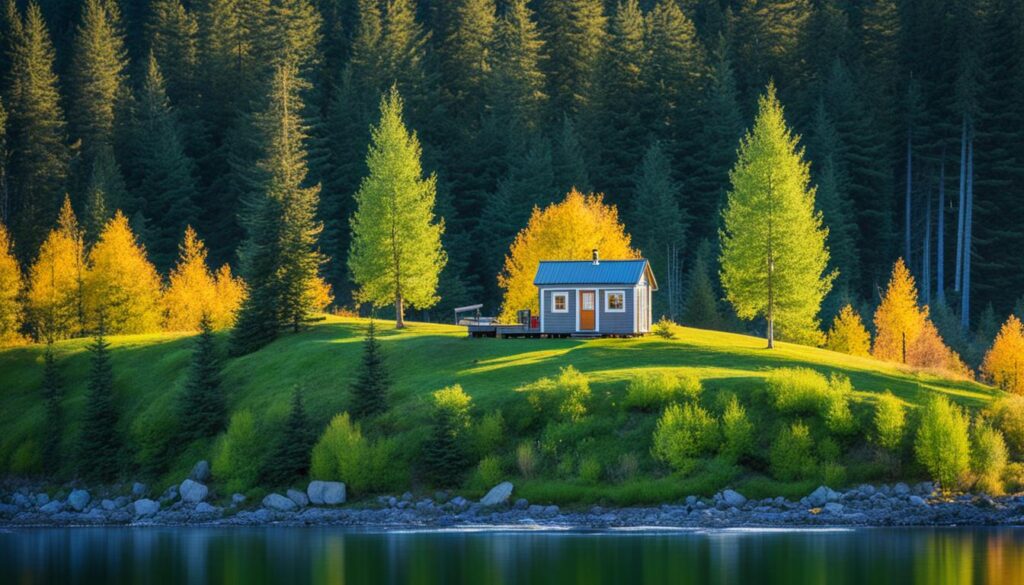
Where Can I Park a Tiny Home in Washington?
When it comes to parking a tiny home in Washington, there are several options available that cater to different needs and preferences. Whether you’re looking for a sense of community or a secluded spot to call your own, here are some of the top parking options for tiny homes in the state.
Tiny House Communities
Tiny house communities are becoming increasingly popular in Washington, providing a supportive and like-minded community for tiny home enthusiasts. These communities often offer shared amenities, such as community gardens, recreational spaces, and common areas for socializing. They provide an excellent opportunity to connect with other tiny house owners and embrace the tiny living lifestyle.
RV Campgrounds
Another option for parking a tiny home in Washington is RV campgrounds. Since tiny homes on wheels are classified as recreational vehicles (RVs), these campgrounds are a suitable choice for parking and living in your tiny home. Many RV campgrounds offer long-term or year-round parking options, allowing you to enjoy the beautiful natural surroundings that Washington has to offer.
Residential Land
If you prefer a more traditional setting, you may find residential land that allows for tiny home parking. However, it’s crucial to research and comply with local regulations and obtain necessary permits before parking a tiny house on residential land. Zoning laws and restrictions may vary from one jurisdiction to another, so consulting with local building departments is essential to ensure compliance.
Agricultural Property
Certain agricultural properties in Washington may allow for the parking of tiny homes. This option provides a unique opportunity to embrace a rural lifestyle while still enjoying the comforts of a tiny home. However, it’s important to check with the property owner and local authorities to understand any specific requirements or limitations that may apply.
When considering any parking option for your tiny home in Washington, it’s important to be aware of the regulations and requirements that may apply. Washington State is known to be tiny house-friendly, but regulations can differ by local jurisdiction. Therefore, it is crucial to consult with local building departments and obtain the necessary permits to ensure a legal and hassle-free parking experience.
“Washington State adopted Appendix Q Tiny Houses with amendments effective from July 1st, 2020.”
In conclusion, Washington offers a range of parking options for tiny homes, including tiny house communities, RV campgrounds, residential land, and agricultural property. By understanding the regulations and requirements in your desired location, you can find the perfect spot to park your tiny home and enjoy the freedom and flexibility of the tiny house lifestyle.
Property Taxes for Tiny Houses in Washington
When it comes to property taxes for tiny houses in Washington, there are some unique considerations to keep in mind. Generally, tiny house owners in Washington do not have to pay traditional property taxes, as these homes are not considered conventional dwellings. This exemption is due to the specific regulations surrounding tiny houses in the state.
However, it’s important to note that if your tiny house has wheels and is classified as a recreational vehicle (RV), you may still be subject to personal property taxes. The exact tax regulations for motor vehicles vary by state, and Washington is no exception. It’s crucial to research and understand the specific tax requirements in the state where your tiny house is located.
By classifying tiny houses as exempt from traditional property taxes, Washington promotes the growth and affordability of the tiny house movement. This allows individuals to experience the benefits of tiny living without the financial burden of property taxes.
For more information on property taxes and tiny houses in Washington, you can visit the Great Lakes Tiny Homes website, which provides insights and resources for those interested in tiny house living in Washington.
Quixote Communities: Providing Housing for Veterans
“At Quixote Communities, we believe that everyone deserves safe and secure housing. Our mission is to provide tiny house communities for veterans, creating a supportive and empowering environment. By offering innovative tiny dwellings, we aim to reduce homelessness and foster a sense of community among our residents.”
In addition to the tax considerations, there are organizations like Quixote Communities in Washington that strive to address housing challenges. Quixote Communities focuses on providing secure housing options for veterans through the development of tiny house communities. Their approach not only provides affordable housing but also creates a supportive environment for veterans to thrive.
When it comes to property taxes for tiny houses in Washington, it’s important to understand the regulations and exemptions that apply. By taking the time to research and educate yourself about the tax requirements, you can make informed decisions and enjoy the benefits of tiny living in the Evergreen State.

Conclusion
Micro living in Washington offers an exciting and sustainable lifestyle, but it’s essential to navigate the regulations and limitations surrounding tiny houses. Fortunately, Washington State is known for being petite house-friendly, with many communities allowing accessory dwelling units (ADUs) and tiny houses on foundations. However, when it comes to parking a tiny house on wheels, there may be more restrictions.
To ensure a smooth and legal living experience in a tiny house in Washington, it’s crucial to consult with local building departments and understand the Washington State Building Code. By complying with all regulations, you can confidently embrace the tiny house movement and enjoy the many benefits it offers, including cost-effectiveness, simplicity, and environmental sustainability.
Whether you choose to live in a tiny house community, RV park, national park, or on private property, understanding the local zoning and development regulations will help you find the right location for your tiny home. Consider working with a certified builder, such as Great Lakes Tiny Homes, to ensure your tiny house complies with safety standards and legal requirements, increasing accessibility to financing and insurance options.
With its diverse landscapes and vibrant communities, Washington offers various opportunities for tiny house living. Explore amenities offered by places like Quixote Communities in Orting, Olympia, and Shelton for veterans, or Lost Lake Resort in Nisqually Valley. Embrace the freedom and simplicity of tiny house living in Washington and create a cozy home that suits your needs and dreams.
FAQ
Where can I put a tiny house in Washington?
Tiny houses can be built in various locations in Washington, such as tiny house communities, RV campgrounds, residential land, and agricultural property. However, parking a tiny house on wheels may be limited to RV campgrounds. It’s important to research and comply with local regulations and obtain necessary permits before parking a tiny house in any location.
Are tiny homes legal in Washington?
Yes, tiny homes are legal in Washington, but regulations may differ depending on the location. For example, in King County, tiny houses must have a permanent foundation. Seattle does not permit micro houses on wheels and requires compliance with accessory dwelling unit (ADU) requirements. Woodland requires ADUs to have a living area ranging from 300 to 800 square feet. It’s important to consult with the local building department before building a tiny house to ensure compliance with the Washington State Building Code.
Where can I build a tiny house in Washington?
You can build a tiny house in Washington in various locations, including tiny house communities, RV campgrounds, residential land, and agricultural property. However, it’s important to research and comply with local zoning and development regulations. These regulations may include requirements for minimum size, parking, and the number of accessory dwellings allowed on residential lots.
What are the rules and regulations for tiny houses in Washington?
Rules and regulations for tiny houses vary in different parts of Washington State. In King County, tiny house owners must build their houses on permanent foundations, and parking tiny houses on wheels is against the rules. Seattle also does not permit micro houses on wheels and requires compliance with ADU requirements. Woodland requires ADUs to have a living area ranging from 300 to 800 square feet. Permanent tiny homes must comply with the Washington State Building Code, while temporary tiny houses on wheels are approved only for temporary use.
How can I get approval for building a tiny house in Washington?
To get approval for building a tiny house in Washington, you need to familiarize yourself with the standards and requirements outlined in the tiny house information packet. Three copies of your plan must be signed by an architect or Washington professional engineer. You’ll also need to fill out the Tiny House Plan Approval & Insignia Request form and the Notification to Local Enforcement Agency form. A plan review fee of 5 is required, and the completed packet can be mailed to the Department of Labor & Industries or submitted in person at an L&I office.
How small can a house be in Washington?
A tiny house in Washington can be as small as 400 square feet or less. It must include a sleeping/living area, a kitchen, and a bathroom. All tiny homes in Washington must comply with the Washington State Building Code. Approval for a tiny house depends on meeting the size requirements and other standards outlined in the tiny house information packet.
Where can I park a tiny home in Washington?
There are several options for parking a tiny home in Washington, including tiny house communities, RV campgrounds, residential land, and agricultural property. Micro dwellings on wheels are classified as RVs, so they can generally only be parked in RV campgrounds. However, it’s important to research and comply with local regulations and obtain necessary permits before parking a tiny house in any location.
Are property taxes applicable to tiny houses in Washington?
Tiny house owners in Washington typically do not have to pay property taxes, as they are not considered conventional homes. However, if the tiny house has wheels, it may be classified as an RV, in which case personal property taxes may apply. The specific tax regulations for motor vehicles vary by state, so it’s important to research and understand the tax requirements in the state where the tiny house is located.
What is the conclusion of the guide?
Micro living in Washington has its benefits, but it’s important to be aware of the regulations and limitations surrounding tiny houses. Washington is generally considered a tiny-house-friendly state, with many communities allowing ADUs and tiny houses on foundations. However, parking a tiny house on wheels may have more restrictions. It’s crucial to consult with local building departments, understand the Washington State Building Code, and comply with all regulations to ensure a smooth and legal living experience in a tiny house in Washington.

